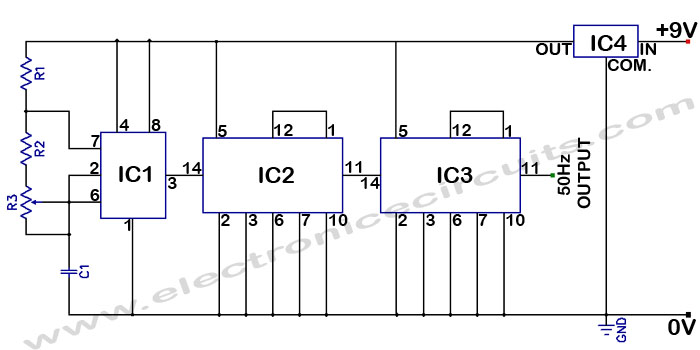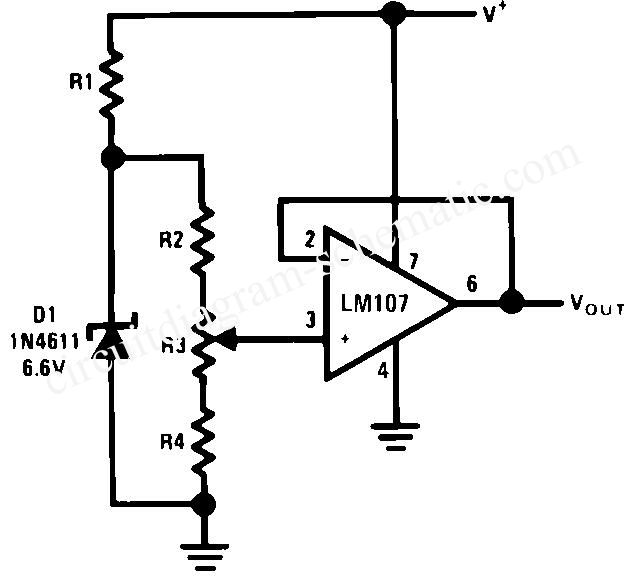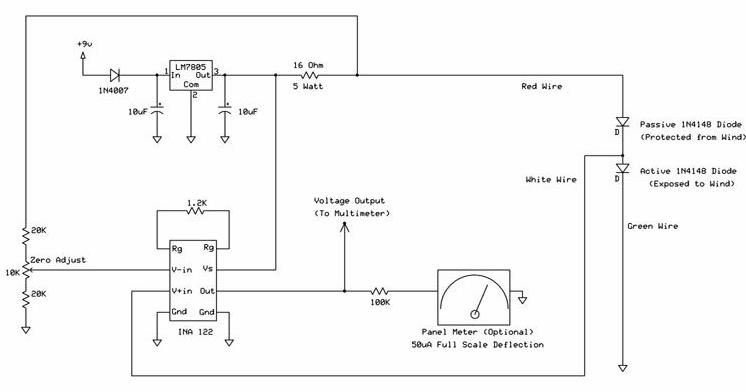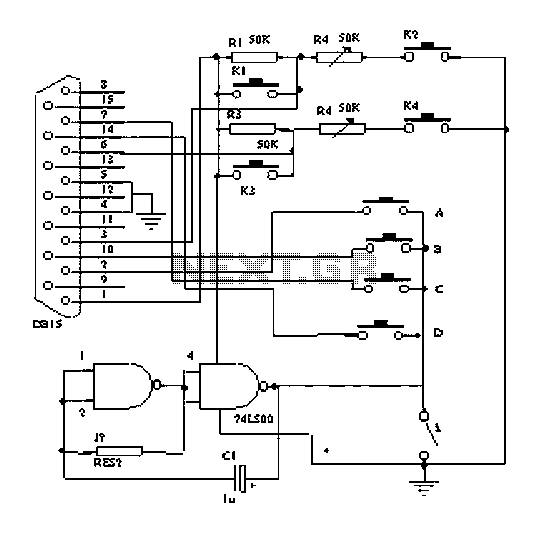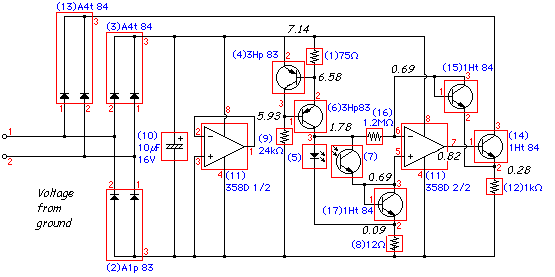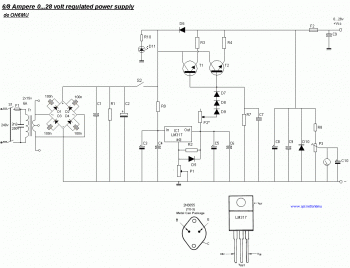
AC Ohmmeter ESR Meter Circuit

The ESR Meter is essentially an AC Ohmmeter equipped with specialized scales and protective circuitry. It provides continuous readings of series resistance in electrolytic capacitors. Operating at 100 kHz, it maintains the capacitive reactance factor close to zero. The circuit design for the ESR meter utilizes eight operational amplifiers. An operational amplifier (op-amp) is an idealized basic amplifier featuring two inputs. The non-inverting input (+) maintains an in-phase relationship with the output, while the inverting input (-) has an out-of-phase relationship. Op-amps are typically employed with negative feedback, achieving a stable operating condition when the voltages at both inputs are equal. Op-amps IA and IB create a regenerative 100 kHz oscillator circuit. Capacitor C1 acts as the primary timing capacitor, with resistor R1 chosen to set the frequency. Diodes D2 and D3 clip the upper and lower portions of the output waveform, ensuring that the output level and frequency remain stable against variations in battery voltage. The oscillator output from op-amp IB drives a 10-ohm source resistor, R8F. The test capacitor, through the test leads, couples this 100 kHz signal to a 10-ohm load resistor, R9F. The voltage developed across this load resistor indicates the ESR value of the capacitor. The 10-ohm resistors set the basic scaling for the meter. Capacitor C3 blocks any DC voltage present on the test capacitor. Diodes D4 and D5 safeguard the ESR Meter from initial charging currents to C3. Resistor R7 discharges C3 after testing. A DC operating bias of 0.55 V is established by diode D1 for the oscillator stage and all subsequent stages, which are DC coupled and operate in class A. The DC bias from D1 and the ESR signal from R9F are combined at the input of op-amp ID. Both voltages are amplified by op-amps ID, IC, and IIA. Each of these three stages has an amplification factor of approximately 2.8, determined by the ratio of output voltage to feedback voltage at the inverting input, which is set by feedback resistors R13F, R14F, and others.
The ESR Meter circuit is designed to accurately measure the equivalent series resistance (ESR) of electrolytic capacitors, which is critical for assessing the performance and health of these components in various electronic applications. The operational amplifiers play a pivotal role in signal processing, with the regenerative oscillator providing a stable frequency reference essential for capacitance measurements. The choice of 100 kHz as the operating frequency is strategic; it ensures that the reactance of the capacitor being tested is minimized, allowing for precise resistance readings.
The configuration of op-amps IA and IB as a regenerative oscillator is crucial for generating the test signal. The timing capacitor C1, in conjunction with resistor R1, defines the oscillation frequency, which is critical for ensuring that the ESR Meter operates within the desired range. The use of diodes D2 and D3 to clip the output waveform is an important feature, as it prevents distortion of the signal due to variations in the power supply voltage, thereby enhancing measurement accuracy.
The test setup, which includes the 10-ohm source and load resistors, is designed to facilitate the measurement of the voltage drop across the load resistor R9F, which is directly proportional to the ESR of the capacitor under test. The blocking capacitor C3 ensures that only the AC component of the signal is measured, while the protective diodes D4 and D5 provide additional safety against transient currents that could damage the circuit components.
The amplification stages provided by op-amps ID, IC, and IIA are configured to ensure that the signal is sufficiently amplified for accurate reading on the meter display. The feedback resistors R13F and R14F are selected to achieve the desired gain, allowing for a linear response across a range of ESR values. This careful design and selection of components contribute to the reliability and effectiveness of the ESR Meter in practical applications, making it an essential tool for electronics engineers and technicians.The ESR Meter is basically an AC Ohmmeter with special scales and protective circuitry. It provides a continuous reading of series resistance in electrolytic capacitors. It operates at 100 kHz to keep the capacitive reactance factor near zero. Here`s the figure of the one design circuit for ESR meter circuit; The ESR meter uses 8 operational ampli fiers. An op-amp is an idealized basic amplifier with two inputs. The non-inverting input (+) has an in-phase relationship with the op-amp output, and the inverting input (-) an out-of-phase relationship. Op-amps are usually used with negative feedback and reach a stable operating condition when their two inputs are equal in voltage.
Op-amps IA & 1B form a regenerative 100 kHz oscillator circuit. Capacitor C1 is the basic timing capacitor and RI is selected to set frequency. Diodes D2 & D3 clip the bottom and top of the output waveform so that the output level and frequency are resistant to battery voltage changes. The oscillator output of op-amp 1B drives 10-ohm source resistor R8F. The test-capacitor, thru the test leads, couples this 100 kHz signal to 10-ohm load resistor R9F. The amount of voltage developed here is indicative of the capacitors ESR value. (The 10-ohm resistors determine the basic meter scaling. ) Capacitor C3 blocks any DC voltage present on the test-capacitor. Diodes D4 & D5 protect the ESR Meter from any initial charging current to C3. Resistor R7 discharges C3 after test. A DC operating bias of 0. 55 V is established by diode D1 for the oscillator stage and for all subsequent stages, which are DC coupled and operated class A.
DC bias from D1 and ESR signal from R9F are combined at the input of op-amp 1D. Both voltages are amplified by 1D, 1C, & 2A. Each of these three stages has an amplification factor of about 2. 8 due to the ratio of output-voltage to feed back voltage at the (-) input, which is determined -by feedback resistors R13F & R14F, etc. 🔗 External reference
The ESR Meter circuit is designed to accurately measure the equivalent series resistance (ESR) of electrolytic capacitors, which is critical for assessing the performance and health of these components in various electronic applications. The operational amplifiers play a pivotal role in signal processing, with the regenerative oscillator providing a stable frequency reference essential for capacitance measurements. The choice of 100 kHz as the operating frequency is strategic; it ensures that the reactance of the capacitor being tested is minimized, allowing for precise resistance readings.
The configuration of op-amps IA and IB as a regenerative oscillator is crucial for generating the test signal. The timing capacitor C1, in conjunction with resistor R1, defines the oscillation frequency, which is critical for ensuring that the ESR Meter operates within the desired range. The use of diodes D2 and D3 to clip the output waveform is an important feature, as it prevents distortion of the signal due to variations in the power supply voltage, thereby enhancing measurement accuracy.
The test setup, which includes the 10-ohm source and load resistors, is designed to facilitate the measurement of the voltage drop across the load resistor R9F, which is directly proportional to the ESR of the capacitor under test. The blocking capacitor C3 ensures that only the AC component of the signal is measured, while the protective diodes D4 and D5 provide additional safety against transient currents that could damage the circuit components.
The amplification stages provided by op-amps ID, IC, and IIA are configured to ensure that the signal is sufficiently amplified for accurate reading on the meter display. The feedback resistors R13F and R14F are selected to achieve the desired gain, allowing for a linear response across a range of ESR values. This careful design and selection of components contribute to the reliability and effectiveness of the ESR Meter in practical applications, making it an essential tool for electronics engineers and technicians.The ESR Meter is basically an AC Ohmmeter with special scales and protective circuitry. It provides a continuous reading of series resistance in electrolytic capacitors. It operates at 100 kHz to keep the capacitive reactance factor near zero. Here`s the figure of the one design circuit for ESR meter circuit; The ESR meter uses 8 operational ampli fiers. An op-amp is an idealized basic amplifier with two inputs. The non-inverting input (+) has an in-phase relationship with the op-amp output, and the inverting input (-) an out-of-phase relationship. Op-amps are usually used with negative feedback and reach a stable operating condition when their two inputs are equal in voltage.
Op-amps IA & 1B form a regenerative 100 kHz oscillator circuit. Capacitor C1 is the basic timing capacitor and RI is selected to set frequency. Diodes D2 & D3 clip the bottom and top of the output waveform so that the output level and frequency are resistant to battery voltage changes. The oscillator output of op-amp 1B drives 10-ohm source resistor R8F. The test-capacitor, thru the test leads, couples this 100 kHz signal to 10-ohm load resistor R9F. The amount of voltage developed here is indicative of the capacitors ESR value. (The 10-ohm resistors determine the basic meter scaling. ) Capacitor C3 blocks any DC voltage present on the test-capacitor. Diodes D4 & D5 protect the ESR Meter from any initial charging current to C3. Resistor R7 discharges C3 after test. A DC operating bias of 0. 55 V is established by diode D1 for the oscillator stage and for all subsequent stages, which are DC coupled and operated class A.
DC bias from D1 and ESR signal from R9F are combined at the input of op-amp 1D. Both voltages are amplified by 1D, 1C, & 2A. Each of these three stages has an amplification factor of about 2. 8 due to the ratio of output-voltage to feed back voltage at the (-) input, which is determined -by feedback resistors R13F & R14F, etc. 🔗 External reference
